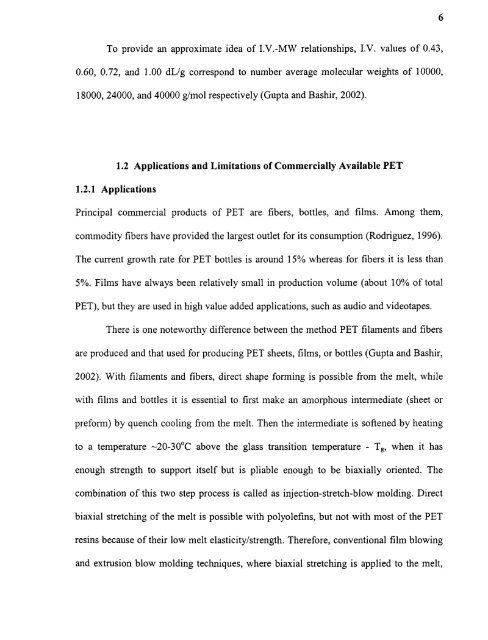A reactive melt modification of polyethylene terephthalate
A reactive melt modification of polyethylene terephthalate
A reactive melt modification of polyethylene terephthalate
You also want an ePaper? Increase the reach of your titles
YUMPU automatically turns print PDFs into web optimized ePapers that Google loves.
1.2 Applications and Limitations <strong>of</strong> Commercially Available PET<br />
1.2.1 Applications<br />
Principal commercial products <strong>of</strong> PET are fibers, bottles, and films. Among them,<br />
commodity fibers have provided the largest outlet for its consumption (Rodriguez, 1996).<br />
The current growth rate for PET bottles is around 15% whereas for fibers it is less than<br />
5%. Films have always been relatively small in production volume (about 10% <strong>of</strong> total<br />
PET), but they are used in high value added applications, such as audio and videotapes.<br />
There is one noteworthy difference between the method PET filaments and fibers<br />
are produced and that used for producing PET sheets, films, or bottles (Gupta and Bashir,<br />
2002). With filaments and fibers, direct shape forming is possible from the <strong>melt</strong>, while<br />
with films and bottles it is essential to first make an amorphous intermediate (sheet or<br />
preform) by quench cooling from the <strong>melt</strong>. Then the intermediate is s<strong>of</strong>tened by heating<br />
to a temperature —20-30°C above the glass transition temperature - T g, when it has<br />
enough strength to support itself but is pliable enough to be biaxially oriented. The<br />
combination <strong>of</strong> this two step process is called as injection-stretch-blow molding. Direct<br />
biaxial stretching <strong>of</strong> the <strong>melt</strong> is possible with polyolefins, but not with most <strong>of</strong> the PET<br />
resins because <strong>of</strong> their low <strong>melt</strong> elasticity/strength. Therefore, conventional film blowing<br />
and extrusion blow molding techniques, where biaxial stretching is applied to the <strong>melt</strong>,

















